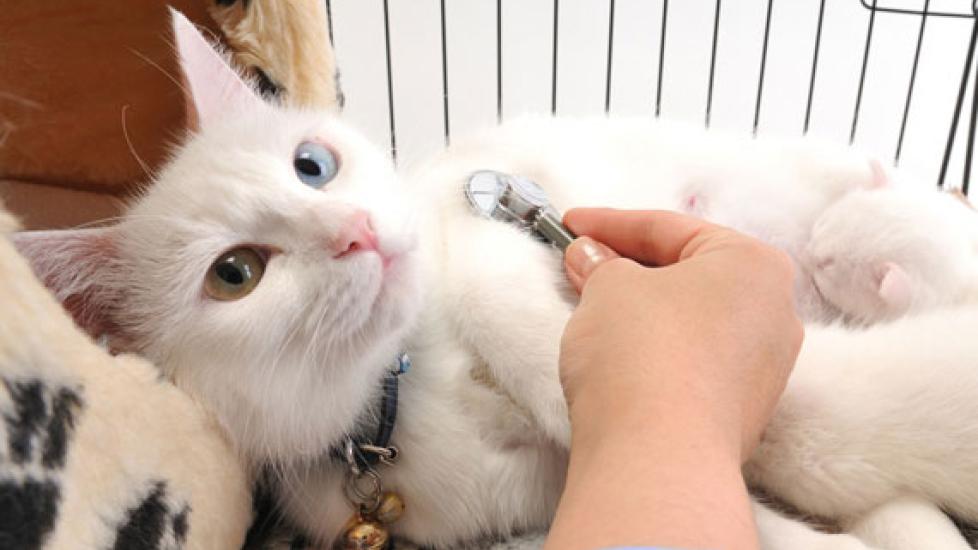Have You Listened to Your Cat's Heart Lately?
I recently attended a continuing education event on feline cardiac disease. The presenters were two cardiologists who work in the same building where I practice.
During the lecture, we were introduced to a “cageside” test called the Cardiopet feline pro-BNP assay. This is a blood test designed to screen cats for occult heart disease.
BNP is the acronym for “brain natriuretic peptide,” a protein originally isolated from the brains of pigs, designed to tell the body to excrete sodium when it is present in excess. We now understand the primary source of BNP is not the brain, but rather the ventricles of the heart, and the main signal for the release of the peptide is excessive stretching of the heart muscle.
One such signal for stretch is the overload that occurs with increased blood volume secondary to increased salt intake. BNP promotes sodium excretion through the urine, and subsequently fluid will flow along with the salt. This helps reduce the body’s blood volume, reducing the stretch on the heart, and the BNP signal is turned off.
BNP levels will be inappropriately elevated in cats with heart disease due to pathological stretch of the heart muscle. The Cariopet feline pro-BNP assay can measure the level of BNP in the bloodstream and serve as an assay for disease.
As I listened to the cardiologists describe the myriad of heart problems cats develop, I found myself wondering, “When was the last time I did a physical exam on my own cats?” I turned to my husband and declared, “We need to check the kids out!”
A few days later, when I actually remembered to bring my stethoscope home from work, we set out on the task of *ausculting our three cats. “Sepsie” and “The Black Cat” were fine, in both demeanor and examination. When it came to my big, fat tabby man, “Nadir,” whether it was a hunch, or mother’s intuition, something told me he was going to have a problem.
I gently placed my stethoscope along his chest and listened intently. Immediately, my ears picked up an irregular rhythm.
Instead of the normal “lub dub” sounds, there were strange pauses in the cadence, intermixed with relatively rapid beats, followed by several seconds of regular heart sounds. My husband, who is also a veterinarian, verified my findings. All signs were pointing to Nadir having a heart problem manifested by an arrhythmia (abnormal heart beat.)
We immediately scheduled a consultation with the cardiologist. We also decided to run basic labwork, including a measurement of his BNP level.
We assumed (incorrectly) since we were both vets, we could just draw the blood at home and bring it to work for submission. However, our many years of school, training, studying, loans, and experience were worth absolutely nothing when it came to dealing with our own pet.
My husband restrained Nadir, while I set up to draw his blood. Within five seconds, my calm, collected angel of a cat detonated into a “kitty bomb” replete with an abnormal amount of claws, teeth, and fur.
He screamed, kicked, bit, and fought his way out of our plan, ultimately leading us to abort our mission. We were forced to bring him to work so the experts (read: veterinary technicians) could do the job we so incorrectly thought we were equipped to do.
Nadir’s labwork results returned later that afternoon, showing all values within the normal range with the exception of his BNP level. This was recorded as over 10 times the normal level. This finding, plus his arrhythmia, all pointed towards an underlying heart problem.
His echocardiogram was scheduled for a few days later and it confirmed that he had significant cardiac disease. He was ultimately diagnosed with unclassified cardiomyopathy with borderline severe left atrial and ventricular dilation. He also had fluid building up in the sac around his heart, indicating a mild to moderate degree of heart failure.
Nadir’s diagnosis was particularly frustrating as very little is known about the progression, treatment, and prognosis of his condition. I found myself in the same position as so many of the owners I deal with who have pets diagnosed with rare cancers. The cardiologist was able to offer several therapeutic options, but we really didn’t know what they would do to help him, or what his outlook would be. He literally could die tomorrow or in several years. There’s simply no way to predict what will happen.
Nadir is now receiving four oral cardiac medications, divided amongst five daily doses. We are on a learning curve of successful administration but we are exceptionally fortunate that (for now) he will take them all with treats. Cat owners of the world, please do not hate me for this. I truly recognize how lucky I am in this capacity.
My experience as the doctor who became the client was certainly humbling. Whether it's cancer or cardiac disease or a simple skin infection, our responsibility as owners is to take care of our pets and make decisions regarding their health care with the greatest combination of scientific evidence, intuition, and love.
The focus in our home is not on prognosis — it’s on the “here and now.” And right now Nadir is sleeping soundly next to me while I write articles that will hopefully help other pets live longer, healthier lives.
We both wouldn’t want it any other way.

Dr. Joanne Intile
*Auscultation: The act of listening, either directly or through a stethoscope, to sounds within the body as a method of diagnosis.
Image: Levent Konuk / Shutterstock
